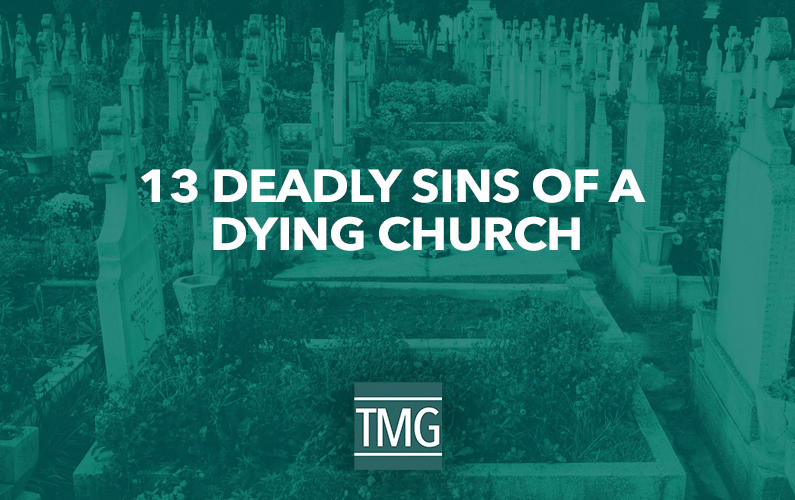No pastor enjoys standing in front of their church and humbly admitting their church is guilty of these “13 Deadly Sins of a Dying Church.” I once worked with a pastor who saw the proverbial “writing on the wall” after reviewing the results of our Church Ministry Analysis.
The pastor readily admitted where he needed to grow and his need for ongoing awareness of his own growth areas. He addressed the needed growth areas head on (not in a haphazard, overly zealous, or critical way). He had to own up to some of the deadly sins of a dying church that directly stemmed from mistakes he made. Talk about being brave! But what happened may surprise you. The church responded with equal levels of humility and motivation to change because they saw it modeled in their leadership.
The statistics consistently show a massive need for a renewed focus on church health. Pastors often know their churches need to be healthier but struggle to take the steps necessary like this pastor did to get there. We settle for our the status quo in lieu of making the necessary changes to experience different results.
Out of our work and research from speaking with hundreds of churches over the last twenty years, we developed this list of “13 Deadly Sins of a Dying Church.” Our goal isn’t to critique or put down pastors and other Christian leaders but to motivate you to action.
Here are the 13 Deadly Sins of a Dying Church
1) The church lacks a process for turning guests into regular attenders.
Guests don’t return for a reason. Something happened before, during, or after their visit with your church that caused them to decide not to stay. Whatever that reason is, do you know what it is? What are you doing about it?
It makes me cringe when I hear someone say “Guests aren’t my responsibility. I’m supposed to preach the word and lead the sheep, not make every guest happy.” Obviously pastors have a responsibility to teach the Word! But how we treat guests is a reflection of how we view the Gospel. Because God showed unmerited kindness and generosity towards us, we should show that same spirit towards newcomers and outsiders.
If we treat guests like outside visitors we don’t expect to come back, they won’t. If we attempt to love guests as image-bearers, loved by God and important to us, they tend to stay.
How does your church need to change how it does things to better love your guests? A simple place to start is by assessing whether you are a friendly church or by downloading this free, short ebook with practical things you can do to improve your guest experience.
2) The church focuses more on internal than external issues.
It is easy to get consumed by day-to-day ministry: visiting people who are sick, preparing messages, and running meetings, etc., and to lose sight of the church’s mandate from Jesus: make disciples. I don’t think pastors intend to shift their focus to internal issues at the expense of impacting their community. It slips unintentionally over time.
Declining churches are often filled with people who think the pastor’s primary role is to keep everyone happy. They’ll call it “tending the flock.”
A more Biblical view comes from Ephesians 4, where leaders are primarily equippers of ministry and the congregation are doers of ministry. This transition empowers the pastor to keep an external focus.
3) They get addicted to programs.
Ever find yourself thinking that you have far too many programs in your church? Many, many pastors have wrestled with this issue over the years. It’s important to reflect on on how the church became so driven by programs in the first place.
The smallest churches often have the fullest calendars.
There is often no rhyme or reason to “why” an event or program exists. Sometimes it’s tradition. Other times it’s habit. Often there are good intentions, but poor execution. There’s no alignment between programs. Ironically, the churches we work with that have full calendars often describe the spiritual vibrancy of their congregation as low.
It’s time to shift away from getting people to programs to guiding people on a pathway. The goal isn’t attendance, it’s life transformation. If your church lacks a clear process of best next steps that leads to spiritual maturity, it’s time to develop a Discipleship Pathway. Here’s an article that can help start you on that process.
4) The facility is neglected.
How are your facilities doing? The building where you church meets can serve as an outside indicator of the health of its people.
This has some nuance to it. Some unhealthy churches hide behind well-manicured grounds. However, it’s rare that a healthy church has a neglected facility. Why? Because healthy churches are externally-focused, and don’t want their facility to be a barrier to an unbeliever hearing the Gospel.
Guests don’t want to see a stained carpet and neglected bathrooms. They want easy access to information not only on-site but also online. When guests see dusty fake plants and weeds growing in your sidewalk, what do they infer about your church?
Everything you do as a church communicates something. Be sure your facility is telling the story to guests that you want them to hear.
5) The senior pastor is expected to visit everyone.
We hinted at this before, but it deserves its own place. This is a fatal flaw because it is usually indicative of much deeper issues. The expectation that the pastor should visit everyone is destroying churches.
Why? Because this expectation reveals that the congregation sees the pastor as their personal chaplain rather than the leader of a Kingdom-building church.
Some people in declining churches genuinely have no desire to reach the community. They simply want the church to outlive them. This is a harsh truth, but it’s the reality for many declining churches.
Fortunately, at TMG, we believe most churches want to change, but don’t know how. It’s critical, then, that pastors be careful not to reinforce the destructive expectation that pastors visit everyone. Instead, be intentional about building layers of support that empower the congregation to live out the 100+ “one-another’s” of the New Testament.
6) Their weekend services aren’t engaging.
How would you describe the worship environment on Sunday mornings? This isn’t about being “flashy.” It’s about being engaging. There is a difference. If your service is predictable, the songs sung have no connection to the sermon, doesn’t engage people at the heart-level, it’s unlikely that the church is very healthy.
Your church’s worship style doesn’t determine how engaging you are; the intentionality you put into planning your services does.
When did you last evaluate the overall environment of the worship service? Sometimes the worship service can feel painful and almost as if everyone is struggling to want to be there. Whether due to poor music preparation, a less-than-relevant message, or announcements that drag on for fifteen minutes, there are dozens of things in a worship service that require intentionality.
7) The church has no plan for leadership succession.
The average church member may not ever have this conversation with the leadership. A pastor who doesn’t keep succession in mind is unintentionally planning to sabotage your church upon departure. If this is acceptable to us, then we are complicit.
Pastors love their people, and don’t like to think about leaving. Yet no pastor is in their position forever! Pastors need two succession plans: the emergency plan (if there were a sudden death or other emergency) and a long-term plan.
Effective succession requires intentionality. In the mainline denominations, there are often systems in place that take care of this issue. Independent churches need to be more intentional.
Let’s take our collective heads out of the sand and address this issue. Let’s move in a direction that affirms the faithful ministry of long-time pastors, the longevity of our churches’ impact, and the gifts and abilities of our younger leaders who are looking to be entrusted with the chance to serve and lead. Intentional successions honor our Lord as we serve with purpose and prioritize His mission over our tenure.
8) The community doesn’t know the church is there or that they care.
Does the community as a whole notice your church’s impact? Rather than trying to do lots of small things in the community, step back and identify one or two areas where your church can make a genuine difference.
A good starting point would be a local school, non-profit, or other area that allows you to invest without needing or expecting anything in return. Your community will take notice when your church sacrificially meets a need in your community, and you don’t feel the need to wear the church t-shirt for branding.
The difficulties will be identifying that need, ending some of what you are already doing in other areas, and focusing all your efforts in one direction. Celebrate your volunteers and their selfless sacrifice, the faithful teachers in your local schools, or others in your community who may appreciate a thank you from your church.
9) They can’t explain their wins.
This one may seem surprising because we don’t like to think of good things in a negative light. But when good things happen and we don’t know why, it reveals that we may have talented people but lack sustainable systems. This is why churches will get 500 people to show up to a Trunk-or-Treat, but have very few of those guests ever come to a Sunday service. Nancy was great at organizing that event, but the church had no system for bridging guests at an outreach event to Sunday morning.
James Clear in Atomic Habits says it best. “We don’t rise to the level of our goals; we fall to the level of our systems.”
10) The church has declining attendance.
Attendance is not the most important measure of ministry fruitfulness. Attendance growth or decline usually is more of a symptom of something else. When your attendance is declining, it usually indicates another sign of ministry sickness.
For example, a decline in attendance could be due to a frustration with leadership. Declining attendance could point to sermons that don’t connect with the real struggles of the people in the church. It could point to a lack of meaningful community or fellowship. It could indicate many things.
Regardless, if your church has declining attendance, there are issues that require attention. Rapid growth isn’t always healthy, but sustainable growth almost always is. This is God’s design in nature: healthy things grow. If your church is seeing a trend of decline, it’s likely the church is unhealthy.
11) Pastor or staff turnover is high.
Pastors and ministry staff rarely leave healthy ministry contexts. They leave unhealthy ministry contexts found in sick and dying churches. How is your church doing with staff turnover? How long do pastors and support staff tend to stay with you? What is driving them to leave your church?
If your church has lost a number of pastors or staff in the last decade, there’s a good chance that the problem wasn’t them… it’s your church. This is tough to hear, but important. Take time for self-reflection and recognize the pockets of dysfunction within your church that are driving leaders away.
12) Prayer is a formality, not foundational.
Prioritized prayer occurs when modeled by the pastor and cultivated among the lay leadership in your groups and families. How are you cultivating the prayer life of your congregation? How are you training parents to pray with their kids? Do children know how to pray?
No approach to prayer should be propped up as the only way. If you truly believe prayer is a priority, you will do more than preach a sermon series on prayer and occasionally mention prayer. You will ensure people know how to pray, get opportunities to pray, and are encouraged to prioritize their time to allow for a focus on prayer.
13) Lay leaders (and pastors) don’t know where the church is heading.
Do the lay leaders in your church know where the church is heading? If we walked into your building and asked a few leaders at random to articulate the vision of your church, would they all answer similarly? What about how your community will look different as a result of your church’s ministry?
At the beginning of our Strategic Envisioning, we ask the leaders of our partner churches, “What is the church’s vision?” In unhealthy churches, these are the answers we typically get:
– I have no idea.
– Whatever the pastor says.
– We don’t get all focused on vision statements. We are here to serve Jesus.
– I think it’s on the back of the bulletin.
These types of statements don’t indicate a lack of faithfulness on the part of the lay leadership. Quite the contrary. Lay leaders want to make a large impact and will faithfully follow strong servant leadership. It shows that the church lacks a shared dream and plan for the future.
As Paul says in I Corinthians 14:8, “If the trumpet does not sound a clear call, who will get ready for battle?”
Which of these areas do you need to address? Where do you see these deadly sins of a dying church in your church and its ministries?
If you are a pastor and you don’t have a clear vision of the future, the bravest thing you can do isn’t to try to go it alone. You likely should collaborate with others. Take tangible action, listen to your leaders, get outside input, and begin clarifying a plan forward that includes vision clarity, precise measures/ends, and a leadership pipeline that equips and develops people for fruitful ministry.
What do I do next?
Great question. The worst thing you could do is nothing with these deadly sins of a dying church! Here are some options:
1) Take action by speaking about this post with your leadership team.
Email the 13 Deadly Sins of a Dying Church to your board, session, council, trustees, deacons, or other oversight body to get their input. Often times beginning the honest conversation is the hardest part!
2) Talk to a Guide on our team.
Set up a free meeting to ask a Guide questions about how your church can get healthy. Whether you’re ready for a process like Strategic Envisioning, or just want a little outside input, we’re here to serve you!
3) Download free resources that can help.
The Malphurs Group puts together free resources and tools for leaders on a regular basis. Here are a few you might find helpful:
- The Church Check-up (A free online assessment that can tell you if your church is healthy or not).
- Free Course on Church Revitalization University (A four-lesson course to get your church ready for a revitalization process)
- Free E-Book “Transforming Guests into Regular Attenders” (Practical tips for improving guest retention)
=============
This article was originally posted by Brad Bridges and was revised and updated by Scott Ball in August 2019.

Scott Ball is the Vice President and a Lead Guide with The Malphurs Group. He lives in East Tennessee with his wife and two children. (Email Scott).
Brad Bridges is a pastor and former consultant with the Malphurs Group. @bradbridges



